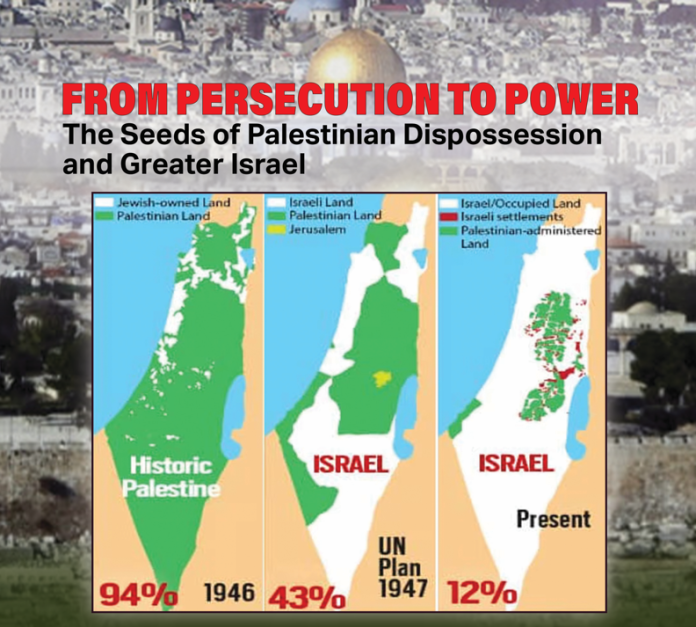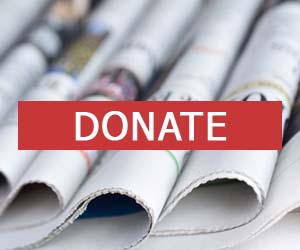– Dr. M. Iqbal Siddiqui
The late 19th century marked a seismic shift in the Middle East, as Jewish refugees, fleeing European persecution, pursued a Zionist vision of a homeland in Palestine. From an Arab and Islamic perspective, grounded in historical facts, this era birthed a profound tragedy: the displacement of Palestinians, whose pluralistic society was sidelined by Zionist ambitions, Western complicity, and Arab disunity. Between the 1880s and 1948, Zionism’s rise – fuelled by strategic lobbying, religious narratives, colonial interests, and an interest-based financial system – sowed seeds of conflict that continue to shape the region in 2025.
For Muslims, this history underscores the erosion of justice (adl), as Palestinian voices were silenced amid global power plays. Today, with ongoing settlement expansion, international inaction, and Palestinian resilience, the struggle demands a renewed commitment to justice, offering pathways to coexistence or escalation.
Jewish Persecution and the Birth of Zionism
European antisemitism drove Jewish migration to Palestine. Pogroms like the 1881 Russian massacres and the 1903 Kishinev massacre (49 killed), alongside the Dreyfus Affair (1894-1906), exposed deep-rooted prejudice. The Holocaust (1933-1945) claimed six million Jewish lives, leading 140,000 survivors to Palestine by 1947. After 1948, nearly 800,000 Mizrahi Jews from Arab countries migrated to Palestine, often amid tensions linked to Zionism, reshaping Israel’s demographics.
Theodor Herzl’s Der Judenstaat (1897) formalised Zionism, envisioning a Jewish homeland to escape persecution. Some factions invoked biblical claims of a “Greater Israel” from the Nile to the Euphrates. Historian Ilan Pappé, in The Ethnic Cleansing of Palestine, critiques the slogan “a land without a people for a people without a land,” which erased Palestine’s vibrant society, setting the stage for systemic dispossession. In 2025, this rhetoric persists in far-right Israeli circles, with X posts amplifying calls for annexation of occupied territories.
Aliyah and Early Displacement
The First (1882–1903) and Second (1904-1914) Aliyah waves brought 65,000 Jewish settlers, backed by European capital and Zionist organisations like the Jewish National Fund. Land purchases, such as the Sursock estates under Ottoman law, displaced Palestinian tenant farmers, disrupting rural economies. Though legal, these transactions left thousands landless, their livelihoods tied to fields now forming Jewish settlements. For Muslims, this paradox – refugees escaping oppression yet imposing hardship – marked a “quiet Nakba,” foreshadowing the 1948 expulsion of 700,000 Palestinians.
By 2025, this pattern continues in the occupied West Bank, where settlement expansion has displaced 150,000 Palestinians since 2000. Israel’s Jewish population reached 7.5 million, with 3 million in settlements, intensifying land disputes and echoing historical dispossession.
Zionist Political Strategies and Global Influence
Zionism’s success relied on strategic lobbying. In Britain, Chaim Weizmann secured the 1917 Balfour Declaration, promising a Jewish homeland, aligning with imperial goals to control post-Ottoman Palestine. In the U.S., the American Zionist Committee influenced Wilson’s Balfour support in 1917 and Truman’s 1946 push for 100,000 Jewish refugees, driven by domestic Jewish voter pressure, per Truman Library archives. These efforts shaped the 1947 UN Partition Plan, allocating 56% of Palestine to Jews despite their 7% land ownership – a disparity Muslims view as a violation of adl.
Herzl’s 1901 offer of debt relief to Sultan Abdul Hamid II for land concessions, rebuffed due to Muslim opposition, destabilised Ottoman governance. In 2025, Israel’s diplomatic influence persists, with normalised ties with UAE and Bahrain (Abraham Accords, 2020) weakening Arab solidarity. Palestinian Authority (PA) negotiations with Israel, often critiqued as conciliatory, reflect ongoing power imbalances.
Interest-Based Economy and Zionist Expansion
Barred from land ownership in medieval Europe, Jewish communities excelled in finance, shaping global systems. By the 19th century, the Rothschilds funded European governments, embedding interest-based (riba) systems, forbidden in Islam (Qur’an 2:275). Their loans supported Zionist land purchases, funnelling capital into Palestine. By 2023, the World Bank reports 95% of global economies rely on interest, marginalising riba-free systems. For Muslims, this shift, partly tied to Jewish financial expertise, clashes with Shariah and indirectly enabled Palestinian dispossession.
In 2025, global financial systems continue to bolster Israel’s economy, with $4.9 billion in annual U.S. aid (Congressional Research Service, 2024) funding military and settlement growth. Islamic finance, growing at 10% annually, offers a counter-model but struggles against dominant interest-based structures, limiting Palestinian economic agency.
Ottoman Palestine: A Pluralistic Tapestry
Under Ottoman rule (1517–1918), Palestine’s 1.9 million inhabitants – mostly Muslims, with Christians and Jews – formed a cohesive society in Jerusalem, Gaza, and Jaffa, sharing markets and festivals. The Balfour Declaration, issued without Palestinian consent, and British Mandate policies favouring Jewish settlers unravelled this harmony. Resistance, including the 1920 Jerusalem riots (9 killed) and 1936-1939 Great Revolt (5,000 dead under British repression), reflected Qur’anic calls to protect the oppressed (4:75).
In 2025, Gaza’s humanitarian crisis – 2.3 million under blockade, with 70% food insecurity (UN, 2025) – and West Bank checkpoint restrictions echo this historical marginalisation. Palestinian cultural festivals, like those in Ramallah, persist as acts of resilience.
Western Support: The U.S. as Zionist Enabler
U.S. support for Israel, pivotal since Wilson’s Balfour endorsement and Truman’s 1946 refugee policy, shaped the UN Partition Plan. By 2025, $260 billion in aid (Congressional Research Service) fuels Israel’s settlement expansion and military dominance. Donald Trump amplified this, recognising Jerusalem as Israel’s capital, moving the U.S. embassy, and brokering the Abraham Accords, prioritising Israel’s security over Palestinian rights. His administration’s 2020 “Peace to Prosperity” plan favoured Israeli annexation, dismissing Palestinian statehood, amplifying Western hypocrisy.
Biden’s “ironclad” support continues, despite global criticism. European nations condemn settlements but maintain €46 billion in EU-Israel trade (Eurostat 2024), undermining Palestinian advocacy. Trump’s policies, unwaveringly pro-Israel, deepened this divide, framing Palestinians as obstacles to peace while empowering Israel’s regional dominance, a stance Muslims view as denying Palestinian self-determination.
Arab Disunity: Betraying the Ummah
The Arab world’s fragmented response exacerbated the crisis. Egypt and Transjordan, divided by British and French mandates, issued anti-Zionist statements but lacked action. The Arab League (1945) failed to intervene, constrained by colonial influence. Haj Amin al-Husseini’s pleas were ignored, while Transjordan’s King Abdullah negotiated with Zionists. This disunity, violating Qur’anic solidarity (3:103), left Palestinians to face Zionist militias alone.
In 2025, Arab disunity persists. Normalisation with Israel by the UAE, Bahrain, and others fragments the Arab League’s stance. Saudi Arabia’s potential normalisation talks, further isolate Palestinians, undermining the ummah’s collective responsibility.
Seeds of Injustice
Zionism’s Revisionist doctrines, like Ze’ev Jabotinsky’s 1923 “Iron Wall,” treated Palestinians as obstacles. Land purchases, Mandate reclassifications, and the 1947 Partition Plan’s inequity – 56% of land for 7% ownership – epitomised injustice. Zionist lobbying, Western support, and interest-based capital destabilised Ottoman Palestine, culminating in the 1948 Nakba, when 700,000 Palestinians were expelled.
In 2025, Israel’s far-right government advances annexation, with 750,000 settlers in the West Bank. X posts highlight “Greater Israel” rhetoric, while Gaza’s ongoing conflict – 43,000 deaths since October 2023 – intensifies Muslim calls for adl. The International Criminal Court’s 2024 warrants against Israeli leaders for war crimes signal growing global scrutiny.
Present-Day Situation and Possible Outcomes
In 2025, the Israeli-Palestinian conflict remains unresolved, intensified by Israel’s settlement expansion, with 3 million settlers in occupied territories and Gaza’s blockade, deepening Palestinian hardship. The PA’s weakened authority and Hamas’s ongoing resistance, including rocket attacks, face internal rifts. The Israel-Iran war, sparked by Israel’s June 13, 2025 strikes on Iran’s nuclear sites, escalates tensions, with Hamas, Iran-backed Hezbollah, and Houthis retaliating. Trump’s policies, including the Abraham Accords and “Peace to Prosperity” plan, prioritised Israel’s security, endorsing annexation and sidelining Palestinian statehood, while his support for Israel’s Iran strikes, including U.S. airstrikes on Fordow, Natanz, and Isfahan, heightened regional volatility (CNN, June 2025). The UN’s 2024 resolution demanding Israel end its occupation lacks enforcement, and U.S. vetoes block Security Council action.
Possible Outcomes:
- One-State Reality: Occupation may create a single state with unequal rights, risking apartheid accusations. Palestinian equal citizenship advocacy grows.
- Two-State Solution: EU and UN-backed talks for a 1967-bordered Palestinian state could emerge post-2025 U.S. elections, but Israel’s far-right coalition and settlements hinder progress.
- Escalation and Regional Conflict: Gaza violence, Hamas resistance, and West Bank tensions, compounded by Israel-Iran clashes, could draw in Iran, Hezbollah, or Syria, destabilising the region.
- Global Advocacy and BDS: The Global advocacy and the BDS (Boycott, Divestment, and Sanctions) movement gains traction in Europe and universities, pressuring Israel economically. Muslim-led campaigns, citing adl, amplify this push.
A Call for Justice
Since 1948, Zionist ambition, Western complicity, Arab disunity, and economic interests enabled Palestinian dispossession. Trump’s Jerusalem recognition and Iran strikes deepened this. In 2025, the Nakba’s legacy persists in settlements, blockades, and inaction. For Muslims, adl (Qur’an 4:135) demands solidarity. Amplifying Palestinian voices, supporting BDS, and pursuing legal accountability uphold the ummah’s duty to address this tragedy.




